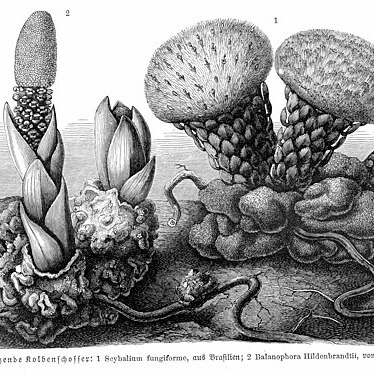Plant monoecious, creamy white to grayish. Rhizome branched or unbranched, surface granular, with pale stellate lenticels; branches subcupular to subglobose, attenuate toward base. Scapes erect, 4-6 cm. Leaves 4 to 7, alternate, oblong to ovate, 1.2-1.5 × 0.9-1.2 cm, lustrous, base asymmetric, apex obtuse to emarginate. Inflorescences ca. 1-2 × 0.6-1 cm, globose to ellipsoid, apex obtuse to rounded. Male flowers: zygomorphic, 10-30 basally on inflorescences or occasionally apically (in Hainan material), subtended by indistinct rudimentary bracts. Perianth lobes 4 or 5, imbricate, rounded, ca. 2 × 2 mm. Synandria subdiscoid, laterally expanded; anthers with 16-20 parallel loculi, dehiscent by short slits. Spadicles clavate, apical 1/3 subglobose; cuticular ridges of apical cells labyrinthlike. Female flowers: mostly on basal stipe of spadicles. Fl. Nov-Dec.
Parasitic herb, monoecious, usually pale yellow; flowering stems usually 2–10 cm tall. Tuber branched; surface finely granular. Leaves c. 3–7, distichous, oblong, c. 1–1.5 cm long, usually deeply forked. Inflorescence bisexual; male flowers few, almost sessile, below female flowers, on a dense terminal fungus-like spadix 8–20 mm long. Male flowers c. 10–20; tepals usually 4, c. 1.5 mm long, the lateral pair ovate, acute, the longitudinal pair oblong, truncate; synandrium c. 1 mm diam. Female flowers surrounding base of many club-shaped processes; style c. 0.5 mm long, slightly exceeding processes.

